Your Effect of ph on bacterial growth images are ready in this website. Effect of ph on bacterial growth are a topic that is being searched for and liked by netizens now. You can Find and Download the Effect of ph on bacterial growth files here. Get all free photos.
If you’re looking for effect of ph on bacterial growth images information connected with to the effect of ph on bacterial growth interest, you have come to the ideal site. Our site frequently provides you with suggestions for viewing the maximum quality video and image content, please kindly surf and locate more enlightening video content and images that fit your interests.
Effect Of Ph On Bacterial Growth. Are neutrophiles and do not fare well in the acidic pH of the stomach. Bacteria and most gram-negative intestinal bacteria other than S. A model for the full range of growth pH Data taken from the literature for the effect of the full pH range on microbial growth were used to compare the effectiveness of the ELPM with either a simple quadratic or the CPM models. Lactobacillus bacteria which are an important part of the normal microbiota of the vagina can tolerate acidic environments at pH values 3568 and also contribute to the acidity of the vagina pH of 4 except at the onset of menstruation through their metabolic production of lactic acid.
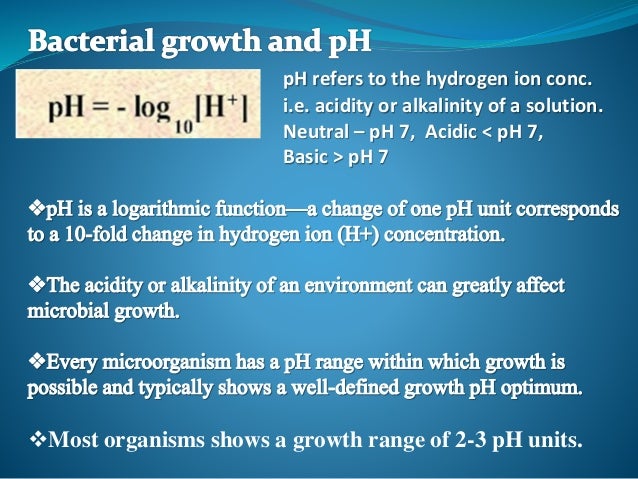 Bacterial Growth And Ph From slideshare.net
Bacterial Growth And Ph From slideshare.net
Sabourauds dextrose agar which has a pH o f 56 is used to isolate fungi that outgrow most bacteria at this pH. Is 7075 but the minimum growth pH is closer to 42. Each curve has an optimal pH and extreme pH values at which growth is much reduced. Bacteria have limitation to their acidity tolerance. Differential medium It distinguishes one microraganism type from another based on a diiference in colony. Additionally some manufacturers adjust pH to change flavor.
PH microbial growth limits for specific types of bacteria Uses for pH adjustment Because of microbial growth limits lowering pH is an effective way to preserve foods and prevent the growth of microorganisms and can also be used as a critical control point in HAACP plans.
Drastic variations in cytoplasmic pH can harm bacteria by disrupting the plasma membrane or inhibiting the activity of enzymes and membrane transport proteins. PH microbial growth limits for specific types of bacteria Uses for pH adjustment Because of microbial growth limits lowering pH is an effective way to preserve foods and prevent the growth of microorganisms and can also be used as a critical control point in HAACP plans. Most pathogenic bacteria grow between pH 72 and 76. Is 7075 but the minimum growth pH is closer to 42. Bacterial growth of Escherichia coli ATCC 25922 and Klebsiella oxytoca ATCC 700324 was determined in pooled human urine adjusted to pH levels between 50 and 80. Drastic variations in cytoplasmic pH can harm bacteria by disrupting the plasma membrane or inhibiting the activity of enzymes and membrane transport proteins.
 Source: researchgate.net
Source: researchgate.net
Many food items such as pickles and cheese are prevented from spoilage by acids produced during fermentation. Very few bacteria such as lactobacilli can grow at acidic pH below 40. The degree to which pH affects growth of these microbes shall be observed subjectively ie visually and. So depending on pH the bacterial community in soil at site1differedfromthatatsite2andalthoughtheacidic soil of site 1 represented a non-optimal pH for bacterial growth the bacterial diversity evenness and richness at this site were higher than those found in the neutral pH soil at site 2. In the present exercise students will examine how pH affects the growth of three common bacteria Escherichia coli Staphylococcus aureus and Alcaligenes faecalis and the eukaryote the yeast Saccharomyces cerevisiae.
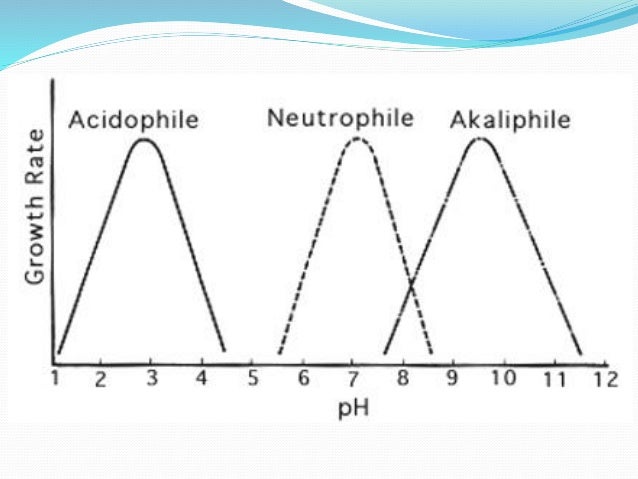 Source: slideshare.net
Source: slideshare.net
Some bacteria produce acid as they grow. In the present exercise students will examine how pH affects the growth of three common bacteria Escherichia coli Staphylococcus aureus and Alcaligenes faecalis and the eukaryote the yeast Saccharomyces cerevisiae. This acid is excreted and lowers the pH or the surrounding environment. Is 7075 but the minimum growth pH is closer to 42. For example the optimum growth pH of Salmonella spp.
 Source: brainkart.com
Source: brainkart.com
A model for the full range of growth pH Data taken from the literature for the effect of the full pH range on microbial growth were used to compare the effectiveness of the ELPM with either a simple quadratic or the CPM models. The curves show the approximate pH ranges for the growth of the different classes of pH-specific prokaryotes. Drastic variations in cytoplasmic pH can harm bacteria by disrupting the plasma membrane or inhibiting the activity of enzymes and membrane transport proteins. Sabourauds dextrose agar which has a pH o f 56 is used to isolate fungi that outgrow most bacteria at this pH. So depending on pH the bacterial community in soil at site1differedfromthatatsite2andalthoughtheacidic soil of site 1 represented a non-optimal pH for bacterial growth the bacterial diversity evenness and richness at this site were higher than those found in the neutral pH soil at site 2.
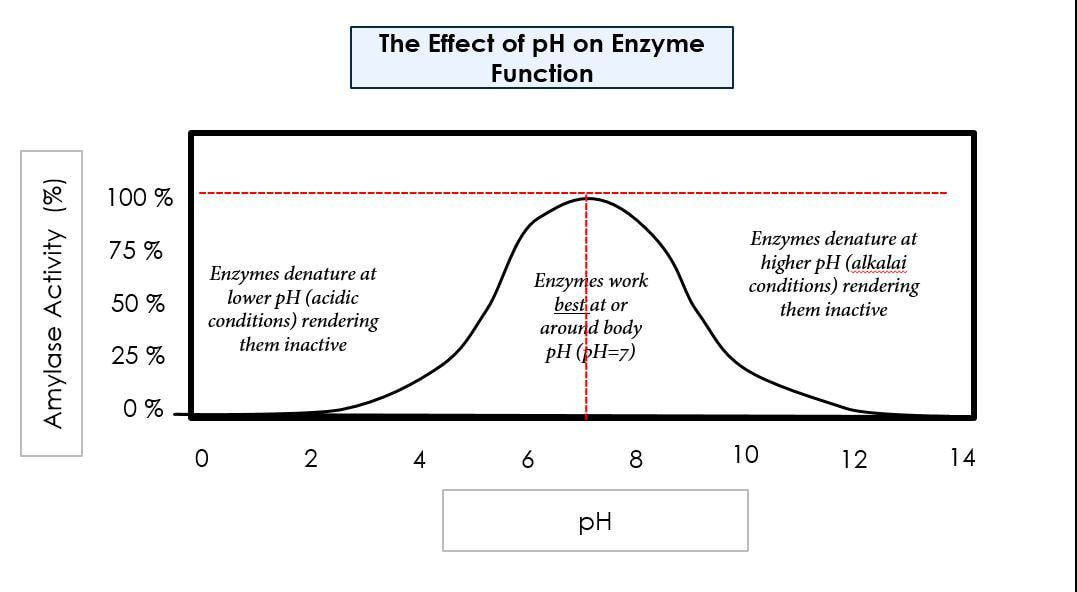 Source: scientistcindy.com
Source: scientistcindy.com
PH microbial growth limits for specific types of bacteria Uses for pH adjustment Because of microbial growth limits lowering pH is an effective way to preserve foods and prevent the growth of microorganisms and can also be used as a critical control point in HAACP plans. Many food items such as pickles and cheese are prevented from spoilage by acids produced during fermentation. Some bacteria produce acid as they grow. Coli bacterial growth was at neutral between 6 and 8. Most procaryotes die if the.
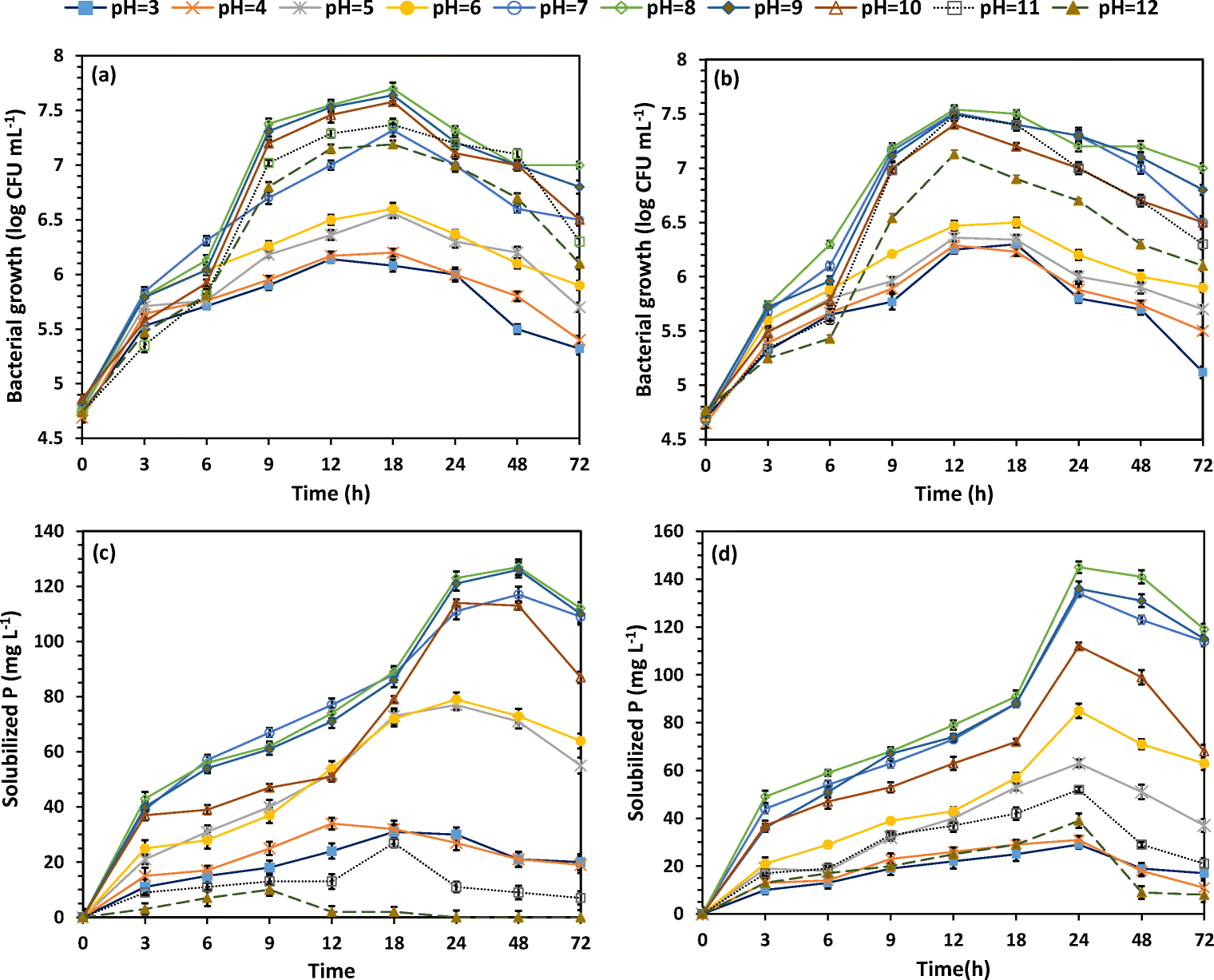 Source: link.springer.com
Source: link.springer.com
When the external pH is low the concentration of H is greater outside than inside and H will move into the cytoplasm which lower internal pH. Differential medium It distinguishes one microraganism type from another based on a diiference in colony. Lactobacillus bacteria which are an important part of the normal microbiota of the vagina can tolerate acidic environments at pH values 3568 and also contribute to the acidity of the vagina pH of 4 except at the onset of menstruation through their metabolic production of lactic acid. A model for the full range of growth pH Data taken from the literature for the effect of the full pH range on microbial growth were used to compare the effectiveness of the ELPM with either a simple quadratic or the CPM models. When the external pH is low the concentration of H is greater outside than inside and H will move into the cytoplasm which lower internal pH.
 Source: researchgate.net
Source: researchgate.net
Most procaryotes die if the. Most bacteria are neutrophiles meaning they grow optimally at a pH within one or two pH units of the neutral pH of 7 see Figure 93. Most procaryotes die if the. A model for the full range of growth pH Data taken from the literature for the effect of the full pH range on microbial growth were used to compare the effectiveness of the ELPM with either a simple quadratic or the CPM models. The vaginas acidity plays an important role in inhibiting other microbes that are less tolerant of acidity.
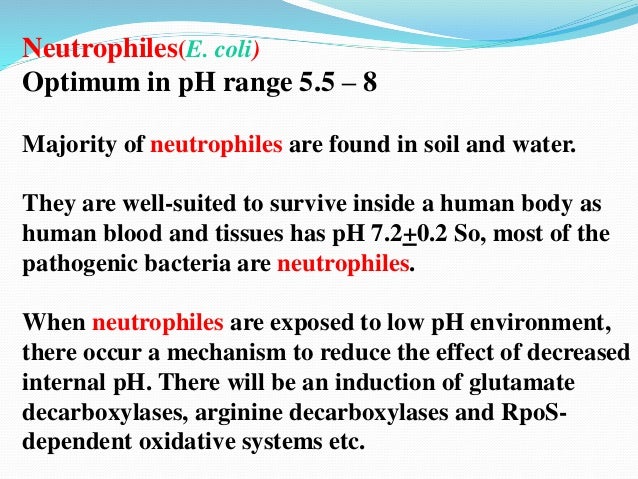 Source: slideshare.net
Source: slideshare.net
Each curve has an optimal pH and extreme pH values at which growth is much reduced. This eventually brings bacterial growth to a halt unless something else in the environment neutralizes the bacterial acid. Sabourauds dextrose agar which has a pH o f 56 is used to isolate fungi that outgrow most bacteria at this pH. Are neutrophiles and do not fare well in the acidic pH of the stomach. Differential medium It distinguishes one microraganism type from another based on a diiference in colony.
 Source: slideshare.net
Source: slideshare.net
The curves show the approximate pH ranges for the growth of the different classes of pH-specific prokaryotes. Bacterial growth of Escherichia coli ATCC 25922 and Klebsiella oxytoca ATCC 700324 was determined in pooled human urine adjusted to pH levels between 50 and 80. The lowest concentration of antibiotic which inhibited visible bacterial growth after 20 h of incubation at 37 C was defined as MIC. Very few bacteria such as lactobacilli can grow at acidic pH below 40. PH microbial growth limits for specific types of bacteria Uses for pH adjustment Because of microbial growth limits lowering pH is an effective way to preserve foods and prevent the growth of microorganisms and can also be used as a critical control point in HAACP plans.
 Source: courses.lumenlearning.com
Source: courses.lumenlearning.com
So depending on pH the bacterial community in soil at site1differedfromthatatsite2andalthoughtheacidic soil of site 1 represented a non-optimal pH for bacterial growth the bacterial diversity evenness and richness at this site were higher than those found in the neutral pH soil at site 2. Most bacteria are neutrophiles meaning they grow optimally at a pH within one or two pH units of the neutral pH of 7 between 5 and 8 see Figure 935. Bacterial growth of Escherichia coli ATCC 25922 and Klebsiella oxytoca ATCC 700324 was determined in pooled human urine adjusted to pH levels between 50 and 80. Most bacteria are neutrophiles meaning they grow optimally at a pH within one or two pH units of the neutral pH of 7 see Figure 93. At pH 60 butyric acid did not affect bacterial growth until the concentration reached 40 mM.
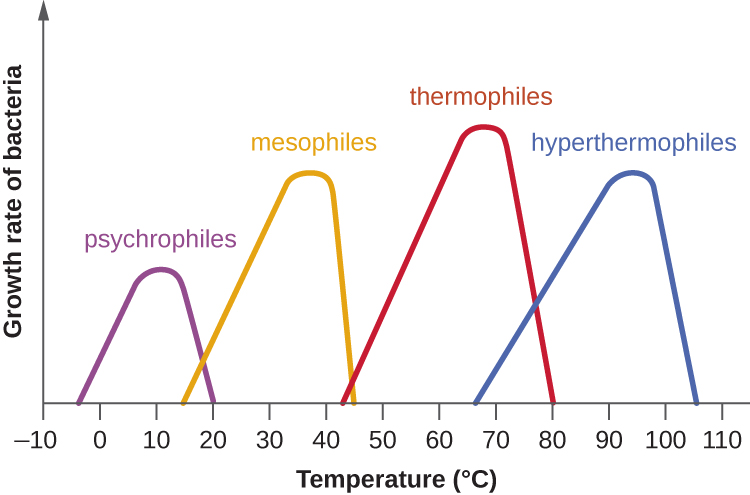 Source: bio.libretexts.org
Source: bio.libretexts.org
Additionally some manufacturers adjust pH to change flavor. This acid is excreted and lowers the pH or the surrounding environment. Very few bacteria such as lactobacilli can grow at acidic pH below 40. When the external pH is low the concentration of H is greater outside than inside and H will move into the cytoplasm which lower internal pH. Lactobacillus bacteria which are an important part of the normal microbiota of the vagina can tolerate acidic environments at pH values 3568 and also contribute to the acidity of the vagina pH of 4 except at the onset of menstruation through their metabolic production of lactic acid.
 Source: researchgate.net
Source: researchgate.net
This eventually brings bacterial growth to a halt unless something else in the environment neutralizes the bacterial acid. The curves show the approximate pH ranges for the growth of the different classes of pH-specific prokaryotes. Very few bacteria such as lactobacilli can grow at acidic pH below 40. Bacteria have limitation to their acidity tolerance. Sabourauds dextrose agar which has a pH o f 56 is used to isolate fungi that outgrow most bacteria at this pH.
 Source: researchgate.net
Source: researchgate.net
PH microbial growth limits for specific types of bacteria Uses for pH adjustment Because of microbial growth limits lowering pH is an effective way to preserve foods and prevent the growth of microorganisms and can also be used as a critical control point in HAACP plans. Lactobacillus bacteria which are an important part of the normal microbiota of the vagina can tolerate acidic environments at pH values 3568 and also contribute to the acidity of the vagina pH of 4 except at the onset of menstruation through their metabolic production of lactic acid. So depending on pH the bacterial community in soil at site1differedfromthatatsite2andalthoughtheacidic soil of site 1 represented a non-optimal pH for bacterial growth the bacterial diversity evenness and richness at this site were higher than those found in the neutral pH soil at site 2. Cholerae is an example of the bacteria that can grow at an alkaline 8289 pH. Are neutrophiles and do not fare well in the acidic pH of the stomach.
 Source: lecturer.ukdw.ac.id
Source: lecturer.ukdw.ac.id
Some bacteria produce acid as they grow. Cholerae is an example of the bacteria that can grow at an alkaline 8289 pH. The curves show the approximate pH ranges for the growth of the different classes of pH-specific prokaryotes. Most bacteria are neutrophiles. Bacterial growth of Escherichia coli ATCC 25922 and Klebsiella oxytoca ATCC 700324 was determined in pooled human urine adjusted to pH levels between 50 and 80.
 Source: researchgate.net
Source: researchgate.net
The maximum concentration of butyric acid available in cows milk after incubation with pre-gastric lipase is approximately 16 mM which would be sufficient to prevent growth of the organisms tested at pH values occurring in the stomach. Most bacteria are neutrophiles meaning they grow optimally at a pH within one or two pH units of the neutral pH of 7 between 5 and 8 see Figure 935. This eventually brings bacterial growth to a halt unless something else in the environment neutralizes the bacterial acid. Most procaryotes die if the. Most bacteria are neutrophiles meaning they grow optimally at a pH within one or two pH units of the neutral pH of 7 see Figure 93.
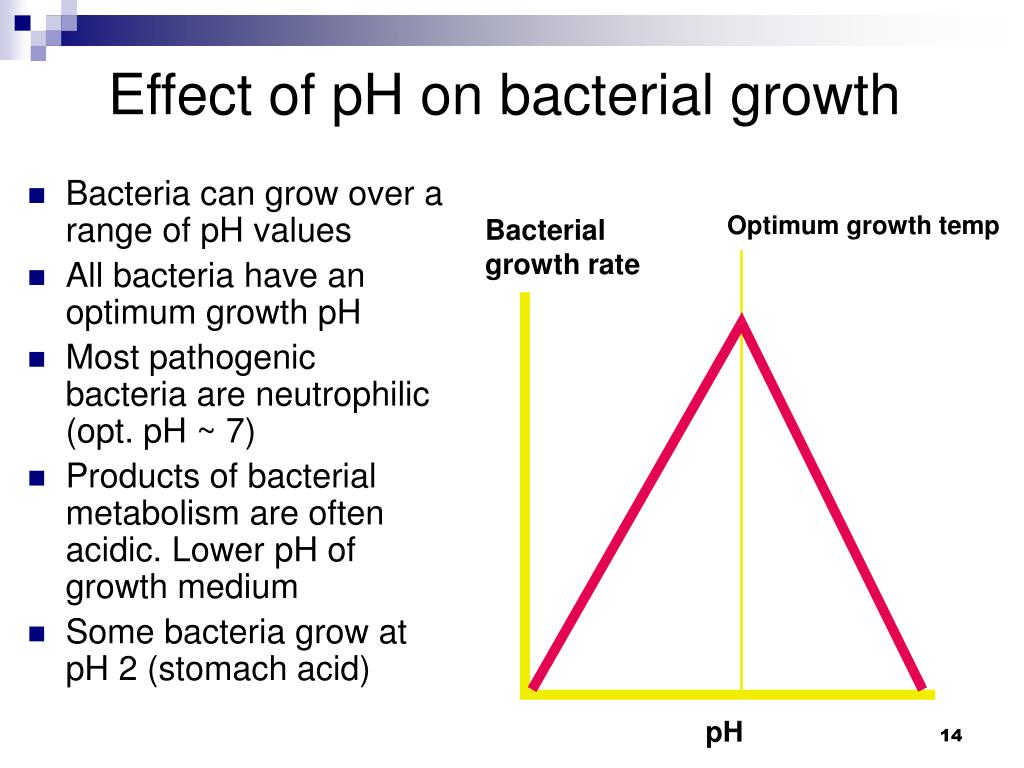 Source: slideserve.com
Source: slideserve.com
Some bacteria produce acid as they grow. In the present exercise students will examine how pH affects the growth of three common bacteria Escherichia coli Staphylococcus aureus and Alcaligenes faecalis and the eukaryote the yeast Saccharomyces cerevisiae. When the external pH is low the concentration of H is greater outside than inside and H will move into the cytoplasm which lower internal pH. Most procaryotes die if the. Most bacteria are neutrophiles.
 Source: sfamjournals.onlinelibrary.wiley.com
Source: sfamjournals.onlinelibrary.wiley.com
A model for the full range of growth pH Data taken from the literature for the effect of the full pH range on microbial growth were used to compare the effectiveness of the ELPM with either a simple quadratic or the CPM models. For example the optimum growth pH of Salmonella spp. Are neutrophiles and do not fare well in the acidic pH of the stomach. Bacterial growth of Escherichia coli ATCC 25922 and Klebsiella oxytoca ATCC 700324 was determined in pooled human urine adjusted to pH levels between 50 and 80. Additionally some manufacturers adjust pH to change flavor.
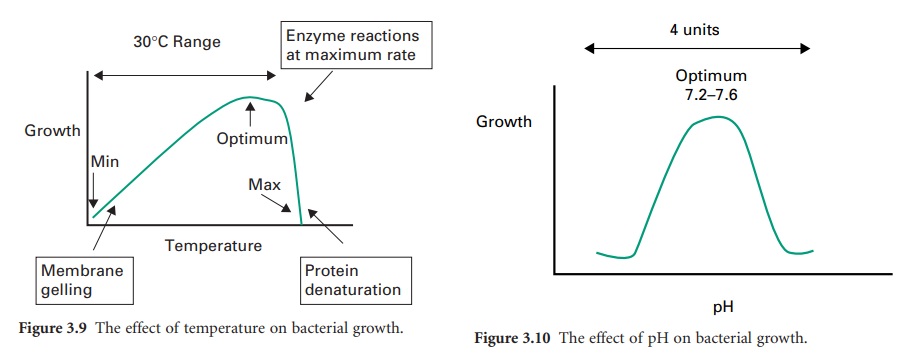 Source: pharmacy180.com
Source: pharmacy180.com
When the external pH is low the concentration of H is greater outside than inside and H will move into the cytoplasm which lower internal pH. In these cases the measured growth rates were used directly where γ. The result showed a significant amount of white opaque circular colonies in the control of water from both parks compared to a few colonies in the tap water control and for other testing Petri dishes our prediction followed the result from the 2008 project done in the California state science fair which concluded that the best pH range for E. Drastic variations in cytoplasmic pH can harm bacteria by disrupting the plasma membrane or inhibiting the activity of enzymes and membrane transport proteins. A model for the full range of growth pH Data taken from the literature for the effect of the full pH range on microbial growth were used to compare the effectiveness of the ELPM with either a simple quadratic or the CPM models.
 Source: alken-murray.com
Source: alken-murray.com
Many food items such as pickles and cheese are prevented from spoilage by acids produced during fermentation. The lowest concentration of antibiotic which inhibited visible bacterial growth after 20 h of incubation at 37 C was defined as MIC. The vaginas acidity plays an important role in inhibiting other microbes that are less tolerant of acidity. Most familiar bacteria like Escherichia coli staphylococci and Salmonella spp. Most procaryotes die if the.
This site is an open community for users to share their favorite wallpapers on the internet, all images or pictures in this website are for personal wallpaper use only, it is stricly prohibited to use this wallpaper for commercial purposes, if you are the author and find this image is shared without your permission, please kindly raise a DMCA report to Us.
If you find this site adventageous, please support us by sharing this posts to your favorite social media accounts like Facebook, Instagram and so on or you can also save this blog page with the title effect of ph on bacterial growth by using Ctrl + D for devices a laptop with a Windows operating system or Command + D for laptops with an Apple operating system. If you use a smartphone, you can also use the drawer menu of the browser you are using. Whether it’s a Windows, Mac, iOS or Android operating system, you will still be able to bookmark this website.






